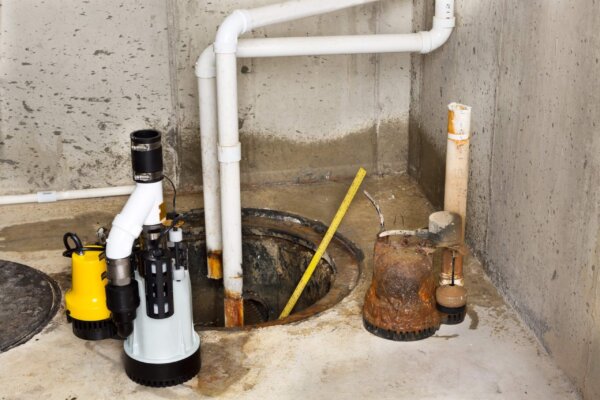How Long Do Sump Pumps Last
How Long Will a Sump Pump Usually Last?
Sump pumps are an essential safety measure for areas that are prone to flooding. If water does ever start to seep into your basement or crawl space, the unit will automatically kick on and start pumping it out of your home to ensure water damage and mold growth don’t become an issue. Like any other piece of equipment, a sump pump can only last so long before it stops working as well or fails altogether. This makes it essential that you regularly check to make sure your pump is still working and also know when to replace it before it fails. As such, it’s important that you know how long a sump pump will typically last, which is what we’ll look at today.
Average Lifespan for Different Types of Sump Pumps
When choosing a new sump pump, one thing you’ll need to decide is whether you need a continuous-duty unit or if you can get by with an intermittent-duty pump. Intermittent-duty pumps are less expensive and tend to have a longer lifespan. This is because the units are designed so that they’ll only ever run for a set period of time before needing to shut off and let the motor rest. This can be a potential issue, as the water could rise quickly enough that your basement or crawl space starts to flood in the time that the pump is off.
Continuous-duty pumps, on the other hand, can run continuously 24 hours a day without ever needing to shut off. While this makes them much more reliable, it also means that a continuous-duty pump will sometimes have a shorter lifespan. If your sump pump only occasionally needs to run and usually not for longer times, then both types will typically last for around 10 years. However, in areas that are prone to flooding where the pump needs to run for many hours at a time, then a constant-duty pump may only last five to seven years instead.
Another factor that can affect the lifespan of a sump pump is whether it’s a submersible or pedestal-style unit. Submersible units are usually much more effective, but they also may not last as long since they sit directly in the sump pit and are constantly exposed to water. That being said, the water that surrounds a submersible pump also helps to cool it and prevent the motor from overheating whenever the unit runs for a long time.
Pedestal-style sump pumps are generally only recommended for areas that rarely experience heavy rains or runoff from snow melt. This is because a pedestal pump has no real way to effectively cool down its motor, which could lead to overheating and the motor burning out if the unit runs for more than a few hours at a time.
Why Maintenance Is Essential for Preserving the Life of Your Sump Pump
Many sump pump owners are unaware that these units need quite a bit of regular maintenance to continue working properly. We always recommend testing your sump pump at least once every three to four months to ensure that it still turns on and pumps properly. You can do this by using a hose or buckets of water to fill up the sump basin until it triggers the float and the pump turns on. If you find that the pump doesn’t turn on, you’ll want to have a plumber repair or replace the unit as soon as possible to ensure your home doesn’t flood.
Cleaning a sump pump’s inlet screen is also essential. The screen works to prevent dirt and debris from getting sucked into the unit and damaging or jamming the impeller. If the screen isn’t cleaned occasionally, it will eventually start to get clogged. A clogged inlet screen will limit the effectiveness of the pump and also put a huge amount of extra strain on the unit’s motor since it will have to work harder to suck water in. The only way to prevent this is to remove the unit from the sump basin and use a brush to clean any debris and gunk off of the inlet screen. This should usually be done once or twice a year, but you may want to do it quarterly if your sump pump gets lots of use.
If you have a submersible sump pump, the inlet screen will be located underneath the base of the unit. On pedestal pumps, the screen is at the end of the intake pipe that sticks down into the sump basin.
It’s also a good idea to take your sump pump outside once a year so that you can fully clean and inspect it for any damage. Cleaning a submersible sump pump is essential, as it helps to prevent rust and corrosion from forming. This is usually something you can easily do on your own, but you may still want to hire a professional plumber since they’ll know what to look for. They can also then handle any repairs or replace the pump if it has any issues.
How to Know If You Need to Replace Your Sump Pump
The most obvious sign that you need to have your sump pump replaced is if it fails to turn on when the basin is full of water, but there are also other ways you can know when it’s time to have the unit replaced. Age is an obvious factor since sump pumps always have a limited lifespan. If possible, you should make a note of when your new pump was installed so that you can be sure to replace it within 10 years. While a pump could potentially last for longer than this, the chances of the unit failing greatly increase the older it gets. After 10 years or so, it’s only a matter of time before the unit dies, so it’s really not worth taking this risk.
Another sign that it’s time to replace your sump pump is if it starts struggling to pump as much water as before and needs to run much longer whenever the sump basin fills up. The first thing to check in this situation is that the inlet screen isn’t clogged. If the screen isn’t clogged and the pump is still struggling to keep up, it usually indicates that the motor is starting to wear out and the unit will soon need to be replaced.
Unusually loud noises when the pump is running also typically indicate that the motor is wearing out or has some issue that is causing it to work much harder. This issue is always easiest to spot with a pedestal sump pump since the motor isn’t submerged, so the unit will always make more noise.
Submersible pumps are much quieter since the water helps to muffle the sounds of the motor. As a result, you may not notice that the pump is louder than usual until the basin is mostly empty and the pump is about to shut off. This is another reason why it’s a good idea to test your pump regularly so that you know how it normally sounds and can more easily detect when it isn’t working correctly.
Sacramento’s Sump Pump and Plumbing Professionals
If your sump pump isn’t working as it should or has reached the end of its lifespan and needs to be replaced, the team at Crystal Blue Plumbing, Heating & Air is here to help. We specialize in sump pump installation and maintenance. We also install and service water heaters, water filtration systems, water softeners, and all other plumbing fixtures and appliances. Our team can assist with leak detection, drain cleaning, and any of your water, sewer or gas line needs. We even have a team of certified HVAC technicians who can keep your home’s heating and cooling systems running perfectly. If you have any questions about sump pumps or need any plumbing or HVAC service in the Sacramento area, give us a call today.







